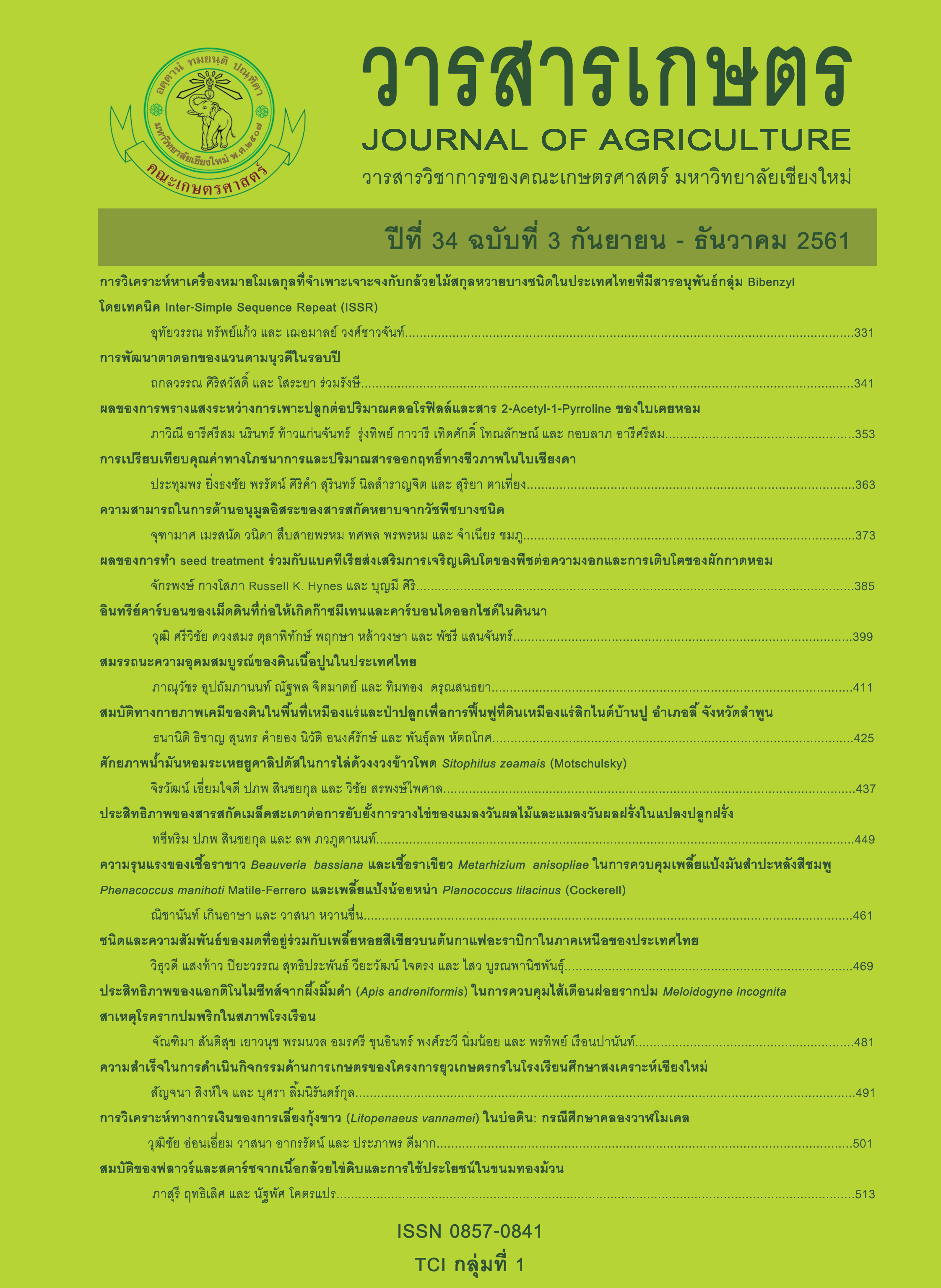อินทรีย์คาร์บอนของเม็ดดินที่ก่อให้เกิดก๊าซมีเทนและคาร์บอนไดออกไซด์ในดินนา
Main Article Content
บทคัดย่อ
งานวิจัยนี้มีวัตถุประสงค์เพื่อศึกษาชนิดของอินทรีย์คาร์บอนในดินและขนาดเม็ดดินที่ก่อให้เกิดก๊าซมีเทน (CH4) และคาร์บอนไดออกไซด์ (CO2) ในดินนา โดยทำการศึกษากับดินร่วนและดินร่วนปนทรายที่ถูกแยกออกเป็น 6 กลุ่มขนาดเม็ดดิน <4 มม. (bulk soil), 4-2 มม. (large macroaggregate, LMa), 2-1 มม. (medium macroaggregate, MMa), 1-0.25 มม. (small macroaggregate, SMa), 0.25-0.053 มม. (microaggregate, Mi) และ <0.053 มม. (fine microaggregate, FMi) ซึ่งแต่ละกลุ่มขนาดนั้นมีทั้งไม่ถูกบด (uncrushed) และที่ถูกบด (crushed) วางแผนการทดลองแบบ Factorial in Completely Randomized Design (CRD) แต่ละเนื้อดินมี12 ตำรับทดลอง ทำ 3 ซ้ำ วิเคราะห์ปริมาณอินทรีย์คาร์บอนในดิน (SOC) อินทรีย์คาร์บอนที่ย่อยสลายง่าย (LOC) และสัดส่วนคาร์บอนที่ย่อยสลายยาก (non-LOC:SOC) แล้วทำการบ่มดินในสภาพไร้ออกซิเจน นาน 14 วัน และวิเคราะห์ปริมาณก๊าซ CH4 และ CO2 ผลการทดลองพบว่าสาร LOC เป็นแหล่งของอินทรีย์คาร์บอนที่เหมาะสมต่อการผลิตก๊าซ CH4 และ CO2 มากกว่าสาร non-LOC ซึ่งเป็นสารอินทรีย์ที่ย่อยสลายยาก ค่าเฉลี่ยปริมาณ LOC ของดินร่วนและดินร่วนปนทรายมีค่า 0.78 มก./กก. และ 0.70 มก./กก. และมีค่าเฉลี่ยสัดส่วน non-LOC:SOC 0.94 และ 0.90 ตามลำดับ โดยที่ดินร่วนมีปริมาณ LOC และสัดส่วน non-LOC:SOC มากกว่าของดินร่วนปนทราย ตำแหน่งของการเกิดก๊าซ CH4 ในดินร่วนเกิดมากที่เม็ดดินขนาด 2-1 มม. ตามด้วยเม็ดดินขนาด 1-0.25 มม. และ 4-2 มม. ส่วนในดินร่วนปนทรายก๊าซ CH4 เกิดมากที่เม็ดดินขนาด 2-1 มม. ในขณะที่การเกิดก๊าซ CO2 ของดินร่วนเกิดมากที่เม็ดดินขนาด 2-1 มม. ส่วนของดินร่วนปนทรายก๊าซ CO2 เกิดมากที่เม็ดดินขนาด 2-1 มม. ตามด้วยเม็ดดินขนาด <0.053 มม. และ 1-0.25 มม.
Article Details
เอกสารอ้างอิง
ชาญยุทธ รัตนพรหมมณี กวิพร จินะจันตา และ อรวรรณ ฉัตรสีรุ้ง. 2560. ผลของลีโอนาร์ไดท์ต่อการปรับปรุงคุณภาพดินและผลผลิตข้าว. วารสารเกษตร 33(2): 215-224.
พัชรี แสนจันทร์ นิภา ธรรมโสม Chhin Phy และ ดวงสมร ตุลาพิทักษ์. 2558. การใช้ถ่านชีวภาพยูคาลิปตัสและฟางข้าวเพื่อการผลิตข้าวและลดคาร์บอนฟุตพริ้นท์อย่างเป็นมิตรต่อสิ่งแวดล้อม. แก่นเกษตร 43(ฉบับพิเศษ 1): 373-379.
Ali, M.A., P.J. Kim and K. Inubushi. 2015. Mitigating yield-scaled greenhouse gas emissions through combined application of soil amendments: A comparative study between temperate and subtropical rice paddy soils. Science of the Total Environment 529: 140-148.
Baver, L.D., W.H. Gardner and W.R. Gardner. 1972. Soil Physics. 4th ed. John Wiley and Sons, New York.
Demirel, B. and P. Scherer. 2008. The roles of acetotrophic and hydrogenotrophic methanogens during anaerobic conversion of biomass to methane: a review. Reviews in Environmental Science and Biotechnology 7(2): 173-190.
Fernandez, R., A. Quiroga, C. Zorati and E. Noellemeyer. 2010. Carbon contents and respiration rates of aggregate size fractions under no-till and conventional tillage. Soil and Tillage Research 109: 103-109.
Helgason, B.L., F.L. Walley and J.J. Germida. 2010. No-till soil management increases microbial biomass and alters community profiles in soil aggregates. Applied Soil Ecology 46: 390-397.
Hobley, E. U., J. Baldock and B. Wilson. 2016. Environmental and human influences on organic carbon fractions down the soil profile. Agriculture, Ecosystems & Environment 223: 152-166.
Intergovernmental Panel on Climate Change. 2007. IPCC Fourth Assessment Report: Climate Change 2007 (Online). Available: https:// www.ipcc.ch/publications_and_data/ar4/wg1/en/tssts-2-1-1.html (June 1, 2016).
Mangalassery, S., S. Sjogersten, D.L. Sparkes, C. J. Sturrock and S.J. Mooney. 2013. The effect of soil aggregate size on pore structure and its consequence on emission of greenhouse gases. Soil and Tillage Research 132: 39-46.
Mc Lean, E.O. 1982. Soil pH and lime requirement. pp. 199-224. In: A. L. Page (ed.). Methods of Soil Analysis, Part II. Chemical and Microbiological Properties. Soil Science Society of America, Madison, WI.
Moody, P.W. and P.T. Cong. 2008. Soil Constraints and Management Package (SCAMP): Guidelines for Sustainable Management of Tropical Upland Soil. ACIAR Monograph No. 130. Australian Center for International Agricultural Research, Canberra.
Plante, A.F., R.T. Conant, C.E. Stewart, K. Paustian and J. Six. 2006. Impact of soil texture on the distribution of soil organic matter in physical and chemical fractions. Soil Science Society of America Journal 70: 287-296.
Puttaso, A., P. Vityakon, F. Rasche, P. Saenjan, V. Treloges and G. Cadisch. 2013. Does organic residue quality influence carbon retention in a tropical sandy soil? Soil Science Society of America Journal 77: 1001-1011.
Ro, S., P. Seanjan, T. Tulaphitak and K. Inubushi. 2011. Sulfate content influencing methane production and emission from incubated soil and rice-planted soil in northeast Thailand. Soil Science and Plant Nutrition 57: 833-842.
Saenjan, P., S. Ro and P. Vityakon. 2015. Methane fluxes and rice yields as a function of sulfate fertilizer with incorporated rice stubble. KKU Research Journal 20(3): 337-345.
Smith, P., D. Martino, Z. Cai, D. Gwary, H. Janzen, P. Kumar, B. McCarl, S. Ogle, F. O’Mara, C. Rice, B. Scholes, O. Sirotenko, M. Howden, T. McAllister, G. Pan, V. Romanenkov, U. Schneider, S. Towprayoon, M. Wattenbach and J. Smith. 2008. Greenhouse gas mitigation in agriculture. Philosophical Transactions of the Royal Society of London B. Biological Sciences 363: 789-813.
Tisdall, J.M. and J.M. Oades. 1982. Organic matter and water-stable aggregates in soils. Journal of Soil Science 33: 141-163.
Walkley, A. and I. A. Black. 1934. An examination of the degtjareff method for determining soil organic matter, and a proposed modification of the chromic acid titration method. Soil Science 37: 29-38.
Yang, X., J. Meng, Y. Lan, W. Chen, T. Yang, J. Yuan, S. Liu and J. Han. 2017. Effects of maize stover and its biochar on soil CO2 emissions and labile organic carbon fractions in Northeast China. Agriculture, Ecosystems & Environment 240: 24-31.
Zheng, J., X. Zhang, L. Li, P. Zhang and G. Pan. 2007. Effect of long-term fertilization on C mineralization and production of CH4 and CO2 under anaerobic incubation from bulk samples and particle size fractions of a typical paddy soil. Agriculture, Ecosystems & Environment 120: 129-138.


